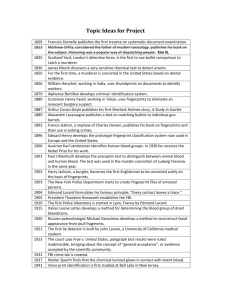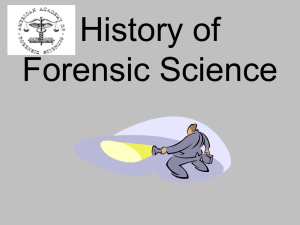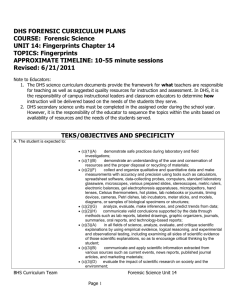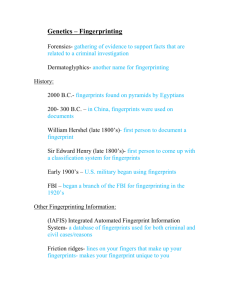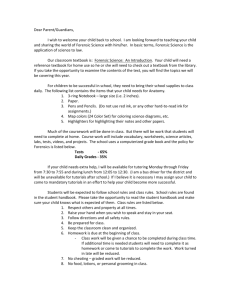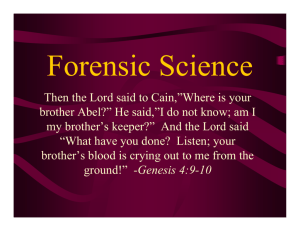History of Forensics
advertisement
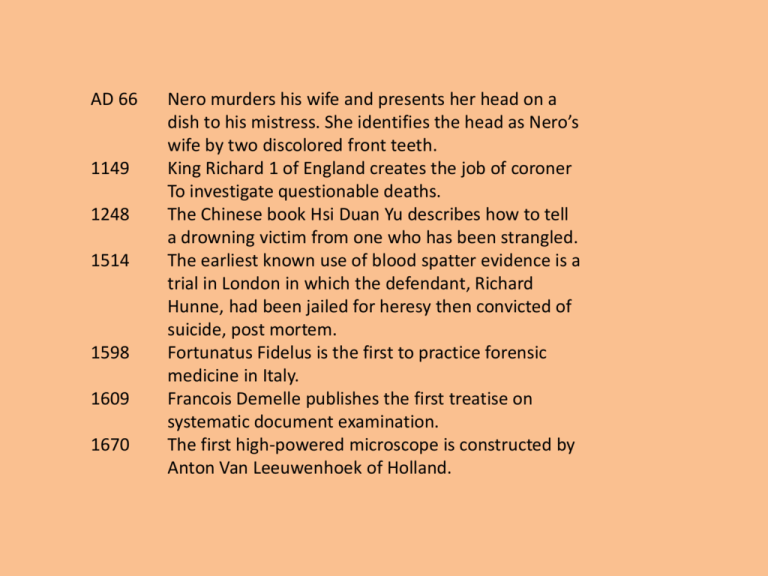
AD 66 1149 1248 1514 1598 1609 1670 Nero murders his wife and presents her head on a dish to his mistress. She identifies the head as Nero’s wife by two discolored front teeth. King Richard 1 of England creates the job of coroner To investigate questionable deaths. The Chinese book Hsi Duan Yu describes how to tell a drowning victim from one who has been strangled. The earliest known use of blood spatter evidence is a trial in London in which the defendant, Richard Hunne, had been jailed for heresy then convicted of suicide, post mortem. Fortunatus Fidelus is the first to practice forensic medicine in Italy. Francois Demelle publishes the first treatise on systematic document examination. The first high-powered microscope is constructed by Anton Van Leeuwenhoek of Holland. 1732 1776 1784 1810 1813 1835 1836 1840 Luigi Galvani discovers that the human nervous system transmits information electrically; this is the basis of current lie detection equipment. The body of General Joseph Warren, killed at the Battle of Bunker Hill, June 17, 1775, is disinterred from a mass grave and identified by Paul Revere, who had made his false teeth. The first documented case of physical matching occurs when an Englishman is convicted of murder because the torn edge of a wad of newspaper in a pistol matches a piece remaining in his pocket. The first detective force, the Süreté, is established in Paris. Mathiew Orflla, considered the father of modem toxicology, publishes his book on the subject. Poisoning was a popular way of dispatching people. Scotland Yard, London’s detective force, is the first to use bullet comparison to catch a murderer. James Marsh discovers a very sensitive chemical test to detect arsenic compounds. Forensic toxicology is first used to convict Marie Lafarge, by use of the Marsh test, of poisoning her husband with arsenic. 1850 For the first time, a murderer is convicted in the United States based on dental evidence. 1856 William Herschel, working in India, uses thumbprints on documents to identify workers. Gustav Kirchhoff and Robert Bunsen develop the science of spectroscopy. The first presumptive test for blood is developed, using the fact that hemoglobin oxidizes hydrogen peroxide. Frenchman Alphonse Bertillon develops a system to identify people using body measurements. Scotsman Henry Fauld, working in Tokyo, uses finger prints to eliminate an innocent burglary suspect. Arthur Conan Doyle publishes his first Sherlock Holmes story, A Study in Scarlet. 1859 1863 1879 1880 1887 1888 American George Eastman invents the first hand-held camera. He calls it the “Kodak” camera and retails it for $25. 1889 1892 1892 1894 1896 1900 1900 1901 Alexandre Lacassagne publishes a text on matching bullets to individual gun barrels. Francis Galton, a nephew of Charles Darwin, publishes his book on fingerprints and their use in solving crimes. Argentina becomes the first country to replace the Bertillon system of measurements with fingerprints when Juan Vucetich solves a particularly gruesome murder using bloody fingerprints. Alfred Dreyfus is convicted of treason in France based, in part, on mistaken hand writing identification by Bertillon. Edward Henry develops the prototype fingerprint classification system now used in Europe and the United States. Scotland Yard adopts the Galton—Henry system of fingerprint identification. Austrian Karl Landsteiner identifies human blood groups. In 1930 he receives a Nobel Prize for this work. Paul Uhlenhuth develops the precipitin test, which distinguishes between human and animal blood. The test was used in the murder conviction of Ludwig Tessnow in the same year. 1902 1903 1903 1904 1905 1906 1910 1910 1910 Harry Jackson, a burglar, becomes the first Englishman to be convicted solely on the basis of fingerprints. Two convicts with the same name and same anthropometry (Bertillon) measurements are found in Fort Leavenworth prison. Two years later, their fingerprints are found to clearly distinguish between them. The New York City Police Department starts to create fingerprint files of arrested persons. This system is adopted by the New York State Prison system two years later. Edmond Locard formulates his famous principle, “Every contact leaves a trace.” President Theodore Roosevelt establishes the FBI. Bite mark evidence is first used in an English court to convict two hungry burglars using teeth marks found in cheese at the scene. The first police crime laboratory is started in Lyon, France, by Edmond Locard. Victor Balthazard publishes the first comprehensive study of human and animal hair. He also uses photographic enlargements of bullets and cartridge cases in an attempt to connect an individual bullet to a particular weapon. American Albert Osborne publishes the seminal treatise Questioned Documents. 1915 1920s 1920s 1921 1922 1923 1923 1932 1937 1940 Italian Leone Lattes develops a method for determining the blood group of dried bloodstains. Russian paleontologist Michael Gerasimov develops a method to reconstruct facial appearance from a skull. He is later popularized as the character Andreev in the detective novel Gorky Park. German investigator George Popp uses botanical and soil identification in solving a crime. The first lie detector is built by John Larson, a University of California medical student. A Nobel Prize is awarded to Englishman Francis Aston for developing the mass spectrometer. The Los Angeles Police Department establishes the first police laboratory in the United States. In the court case Frye v. United States, polygraph test results were ruled inadmissible, bringing about the concept of “general acceptance,” or evidence accepted by the scientific community. The FBI crime laboratory is created. Walter Specht finds that the chemical luminol glows in contact with latent blood. Landsteiner and Wiener describe Rh blood groups. 1941 1948 1950 1952 1954 1955 1957 1959 1960 Voiceprint identification is first studied at Bell Labs in New Jersey. Keith Simpson launches the science of bite mark analysis (forensic odontology) when he examines bite marks on a dead woman. The American Academy of Forensic Science is founded in Chicago. British researchers Martin and Synge receive the Nobel Prize for their invention of gas—liquid partition chromatography, a powerful method of analyzing mixtures of drugs and poisons. R. E Borkenstein, a captain in the Indiana State police, invents the Breathalyzer for field sobriety testing. The murder trial of Dr. Sam Sheppard publicizes blood spatter evidence, as well as inspiring several movies, TV programs, and books. The growth stages of skeletal bones are identified by Americans Thomas Mocker and Thomas Stewart, forming the basis of forensic anthropology. James Watson and Francis Crick discover the DNA double helix. Gas chromatography is used for the forensic identification of petroleum products. 1973 1975 1977 1977 1978 1979 1984 1986 Canada’s Royal Canadian Mounted Police (RCMP) finish computerizing their fingerprint files. The Federal Rules of Evidence are enacted. In Japan investigators accidentally discover that superglue develops latent fingerprints. A limited computerized scanning mechanism is first used to develop a database in forensic science by the FBI’s Automated Fingerprint Identification System (APIS). Britain’s Yorkshire Ripper case highlights the value of computers in investigating serial killings and leads to the development of “psychological profiling” techniques in the following decade. Bite mark evidence is a key in convicting serial killer Theodore “Ted” Bundy. Professor Alec Jefferies discovers that each human being has unique DNA, except in the case of identical twins. The polymerase chain reaction (PCR) DNA replication technique is developed specifically for forensic use by Cetus Corporation. 1987 1990 1991 1993 1996 1996 1998 DNA profiling is used to identify Colin Pitchfork as the murderer of two girls in England and to exonerate someone previously suspected of the murder. Three months later, the same techniques are applied to convict Tommy Lee Andrews for a series of sexual assaults in Florida. Author Patricia Cornwell’s first novel, Postmortem, is published featuring good forensic science, as do more than ten subsequent books. A computerized, automated imaging system is introduced for comparing marks of bullets and shell casings. It is called the Integrated Ballistics Identification System, or IBIS. The following year, a similar system, called Drugfire, is introduced in the FBI. In the court case of Daubert v. Merrell Dow, the court changes the standard of admission of scientific evidence. Computerized searches of the AFIS fingerprint database are implemented by the FBI, using both live scan and card scan devices. Mitochondrial DNA typing is admitted in a U.S.court for the first time. An FBI DNA database, NIDIS, is initiated.
